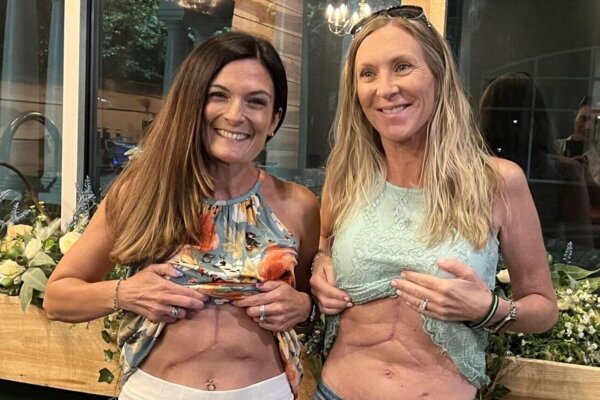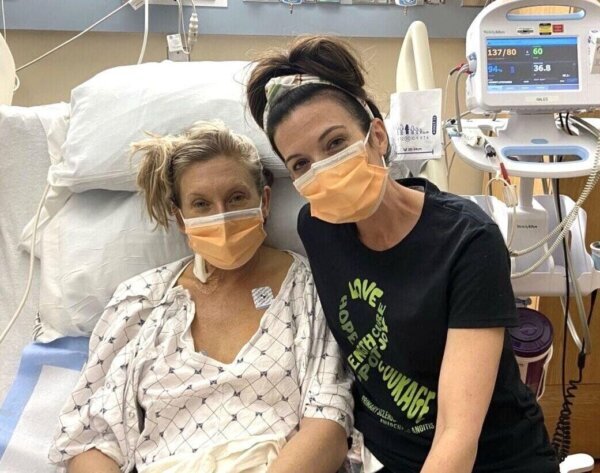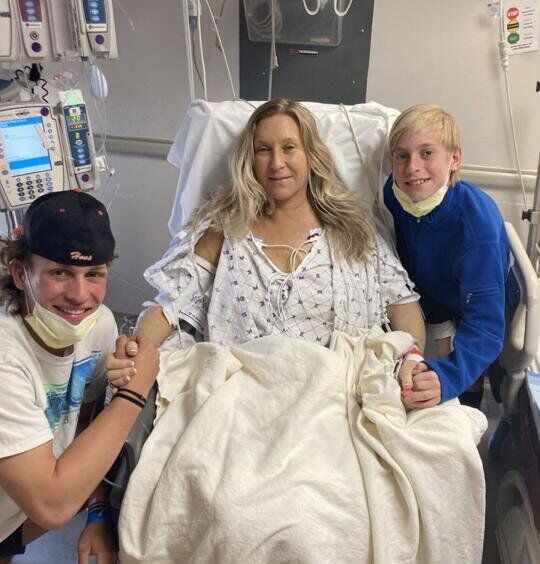This article was republished with permission from WTOP’s news partner InsideNoVa.com. Sign up for InsideNoVa.com’s free email subscription today.
This article was written by WTOP’s news partner InsideNoVa.com and republished with permission. Sign up for InsideNoVa.com’s free email subscription today.

Stephanie Merritt was running out of options.
The rare liver disease she was diagnosed with over 25 years ago was worsening at an alarming rate. Three bouts with different COVID variants and pneumonia had each left her more drained than the last.
“My liver said, ‘I’m done,’” said Merritt, a 45-year-old mother of two who lives in Gainesville.
She was sleeping 12 hours a day, sometimes more, she recalled, and turning “yellow as a minion” from jaundice caused by the disease, Primary Sclerosing Cholangitis (PSC).
Doctors don’t know what causes the disease, which inflames the bile ducts in the liver until they’re narrowed and blocked. Even worse, there’s no true cure, just ways of managing it.
Last fall, Merritt received the message from the doctor who’d been treating her for over a decade: Her liver was approaching failure, and she would need a transplant.
“I can’t manage it anymore,” he told her. “I can’t put a stent anywhere anymore. I don’t have any other treatments.”

A living donor for any organ transplant is a patient’s best bet, but not everyone can find someone who is a match after the exhaustive battery of tests done on potential donors. Blood tests, X-rays, CT scans, physicals and a tissue-matching analysis all have to come back correctly for doctors to feel confident the transplant will work and the patient’s body won’t reject the new organ.
Dozens of family members and friends were tested to see whether they were a match. Even classmates of Merritt’s oldest son – a student at Gainesville High School – went to try to be tested, only to find out they were too young (living donors must be at least 18 years old). More than 40 people were turned away at varying stages, each rejection a new letdown for Merritt and her family.
“It was stressful,” she recalled. “As a mom, the last thing you want is your kids worrying about you.”
‘I just couldn’t get it out of my head’
On Christmas Eve, Jennifer Perilla was very much in the spirit of the holiday. Weeks before, she had read a Facebook post from a woman she didn’t know but whose daughter was in desperate need of a new liver. It had been shared by a friend of a friend and had been bouncing around Perilla’s head since she read it, even though she didn’t know the person who wrote it or the person who needed the transplant.
“You see things like that, versions of things like that, but you kind of read it and keep going,” said Perilla, principal at Tyler Elementary School in Gainesville. “But I just couldn’t get it out of my head.”
That post had a link to a preliminary MedStar Georgetown Hospital screening form. That night, Perilla filled it out and sent Merritt a message, unsure what etiquette dictates in such a situation. She asked Merritt if she’d want updates about the process or if she wanted more privacy, not knowing how many people had already started the testing process.
“I was kind of thinking about false hope, and that by the time you have your family and friends asking the public for help, you’ve probably gone through your immediate family and your best friends and co-workers,” Perilla said. “So I did want to be respectful that those closest to her have probably been really devastated to learn that they couldn’t be her donor.”
To her surprise, Merritt responded enthusiastically, asking for as many updates as Perilla could share.
“I didn’t want to sound crazy,” Merritt told InsideNoVa. “I remember just feeling so grateful and so thankful. I told her, ‘I don’t want to overwhelm you.’”
They didn’t know it then, but Jennifer would turn out to be the perfect match.
‘She is essentially me’
Unlike in kidney donations, liver donations rely on the organ’s regenerative properties. To be a donor, a person’s liver must, in essence, be big and healthy enough to sustain two people for about three months while the pieces regenerate. Up to 60% of a donor’s liver is transplanted into the recipient, replacing the diseased liver. Then, both pieces hopefully regrow into full, healthy organs.
As the weeks went by and Perilla passed several rounds of testing, she and Merritt finally met at the Hilton Garden Inn bar in Haymarket for mocktails. The two hit it off, realizing they had more in common than just both being immersed in the transplant process.

“I just couldn’t get past the fact that she is essentially me, that she is my age, she has two kids, that this could have been any of us,” Perilla said. “Any of us could have been in the unfortunate position to have just been born with a rare disease, and you don’t get control over that. You don’t get say over that, and all of a sudden you’re in a position where you’re asking for help.”
She remembers receiving the call on March 14 telling her that she had officially been named the donor. Perilla immediately called Merritt to share the news. By that time, the two had been sharing messages almost every day about the process, becoming fast friends.
There was still one final test, though: a crossmatch in which blood from the donor and recipient are mixed to make sure that the recipient’s cells won’t attack and kill the donor blood cells. It came back negative, meaning the two were compatible.
Even after months of getting to know Perilla, a part of Merritt still couldn’t fully wrap her head around why she would do so much for someone who had been a stranger. On the day of their surgeries in April, the two convinced hospital staff to let them see each other just before going into the operating room.
“I thought, ‘Oh my God, she showed up,’” Merritt remembers. “She’s a really strong, strong woman. She touched more people than just me.”
About eight hours later, the procedure was complete.
‘Anyone can do it’
In sharing her story, Perilla doesn’t sugarcoat things. The process was arduous, surgery comes with risks for even the healthiest people and the recovery was long. Luckily for her, it has gone relatively smoothly, but she still had to take an extended leave from Tyler Elementary.
But Perilla also says that there’s no part of her that regrets choosing to fill out that form on behalf of a total stranger last Christmas, or following up for the months of doctor’s visits and tests. Not only does she not regret it, she’s been encouraging anybody who can to see whether they might be eligible to donate.
“My biggest hope and goal with all this is to normalize helping other people,” Perilla said. “People are like, ‘Why would you do that for someone you don’t even know?’ … Or they’ll say, ‘You’re such a hero.’ And while that is so kind and I would never want to sound like I’m not grateful for their kindness, ‘hero’ makes it sound like only a few people can do it, instead of no, literally if you’re healthy enough and you match, anyone can do it.”
According to the United Network for Organ Sharing, 103,000 people currently need an organ transplant in the U.S. So far this year, 11,477 people have donated. People can register to be a potential organ, eye and tissue donor with Donate Life America at donatelife.net. The MedStar Health website also has information about becoming a liver or kidney donor locally.
“This is literally a life-and-death situation for another human being,” Perilla said. “They shouldn’t owe me anything or I shouldn’t have to somehow decide they deserve it.”







